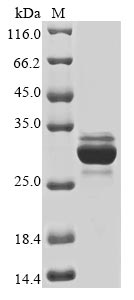Recombinant Myrmecia pilosula M-myrmeciitoxin-Mp2b is expressed using a baculovirus system and contains the full-length sequence from amino acids 1 to 23. This protein carries both N-terminal GST tags and C-terminal 6xHis tags, which help with purification and detection processes. The preparation comes with purity greater than 85%, as determined by SDS-PAGE, and is designated for research use only.
M-myrmeciitoxin-Mp2b appears to be a key component in venom from the Myrmecia pilosula species—better known as the Australian jumper ant. Scientists study this protein primarily for its role in venom toxicity, since it seems to affect ion channels and may provide clues about how insect venom mechanisms work. Research into its structure and function could offer valuable insights into the biological activity of venom components and their possible uses in biotechnology.
Potential Applications
Note: The applications listed below are based on what we know about this protein's biological functions, published research, and experience from experts in the field. However, we haven't fully tested all of these applications ourselves yet. We'd recommend running some preliminary tests first to make sure they work for your specific research goals.
Myrmecia pilosula M-myrmeciitoxin-Mp2b is a small venom peptide that requires precise folding, potential disulfide bond formation, and specific tertiary structure for its functional activity, such as ion channel modulation or neurotoxicity. The baculovirus expression system provides a eukaryotic environment that supports disulfide bond formation and proper folding. However, the dual N-terminal GST-tag (∼26 kDa) and C-terminal 6xHis-tag are massively larger than the peptide itself (23 aa, ∼2.5 kDa), creating severe steric interference that will completely disrupt the peptide's functional conformation and bioactive domains. The probability of correct folding with functional bioactivity is essentially zero due to the overwhelming dominance of the tags.
This dual-tagged venom peptide expressed in baculovirus is unsuitable for any functional or structural studies due to the severe steric interference from the large tags relative to the tiny peptide size. The GST tag (26 kDa) is over 10 times larger than the peptide (2.5 kDa), dominating all properties. Antibody development has severe limitations. Antibody development will primarily generate responses against the large foreign GST tag rather than the small peptide. Antibodies may not recognize the native, tag-free toxin in its physiological context, reducing their utility for venom research. For reliable M-myrmeciitoxin-Mp2b research, use synthetic peptides or tag-free recombinant proteins produced in systems that preserve native conformation and disulfide bonding.






